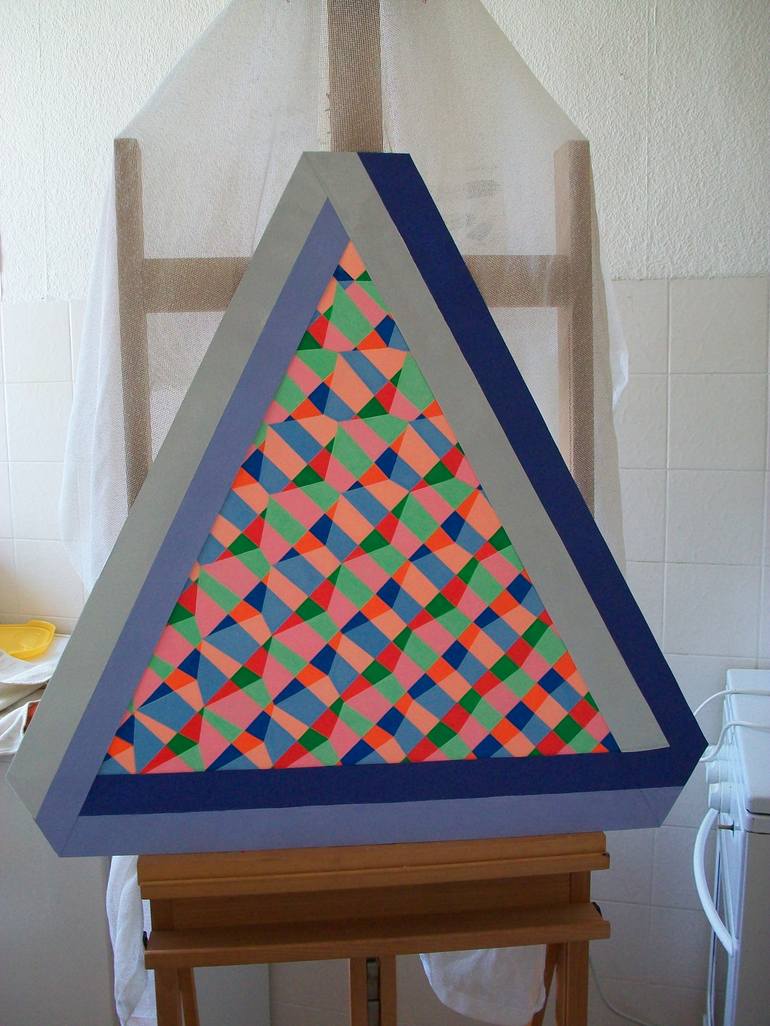


VIEW IN MY ROOM
Penrose Triangle Painting
Germany
Painting, Acrylic on Cardboard
Size: 40 W x 40 H x 2 D in
Ships in a Box
About The Artwork
this is inspired by the English psychologist Roger Penrose , who created many unsettling ,ambiguos ,visual illusions.These abstract works are based on the science of art , most are fluorescent, 3D. visual illusions and are mathematically generated. ( sorry about my personal clutter in the picture but I am no technophobe - just a painter) ! Human perception has very much to do with anticipation, from past experience and knowledge. When we visit the opterimist to get our eyes tested we are presented with random letters , because when we can guess we make ready assumptions ! The triangle is made of reflexive material , and my picture s are designed to be seen under black light , but function in normal light conditions- most can be viewed vertically or horizontally ! - please - 4 Pictures for the price of one folks ! my other great Inspiration is the physicist Richard Feynman, who was the first to realize that classical Newtonian physics could not be imposed on atomic phenomena- only the new mathematics of Quantum Mechanics can describe the bizarre behaviour of the atomic world !
Details & Dimensions
Painting:Acrylic on Cardboard
Original:One-of-a-kind Artwork
Size:40 W x 40 H x 2 D in
Frame:Not Framed
Ready to Hang:Not applicable
Packaging:Ships in a Box
Shipping & Returns
Delivery Time:Typically 5-7 business days for domestic shipments, 10-14 business days for international shipments.
Handling:Ships in a box. Artists are responsible for packaging and adhering to Saatchi Art’s packaging guidelines.
Ships From:Germany.
Customs:Shipments from Germany may experience delays due to country's regulations for exporting valuable artworks.
Have additional questions?
Please visit our help section or contact us.
Germany
Hi, I am Lena and I live in Berlin.The abstract pictures in this collection are a series of artworks developed on the theme of "The Science of Art". I have done much research -for example : - The atomic phenomena known as " light ",- which enables the sensation that we call " vision " -( do not all artists manipulate light ?) . - Vision, - human vision is stereoscpic . - Human perception and visual illusions-( most of which are developed by pshychologists and reveal much about the way we think.) - The corresponding development in science and art towards ever increacing abstraction- in the 1850s the nature and behaviour of atomic entities broke all the Classical rules of Newtonian physics. -for example 1. Atomic particles travel at speeds of 180,000 miles per second - the Speed of light !! 2. - It is impossible to know both - the position and the speed and mass of a particle , at the same time ! 3. - Atomic particles behave as particle and wave at the same time- this is known as " "Duality ! " 4. - We cannot actually see atomic particles , we can only " infer " their prescence in experiments !. 5. Everything on earth is made up of Atoms ! In the late 1850s , art also became increacingly abstract - eg The Impressionists and their interest in the science of light , the pointillists who broke light up into further abstraction , the cubists , who rejected a fixed perspective poiint in favour of multiple view points ( which is much closer to the actual experience of vision and " sacaades" ), abstract expressionism, etc. 6 - Colour wavelength , and the electromagnetic spectrum. 7 -Mathematics in art . The abstract paintings are mostly 3D.and mathematically generated, ,many are fluorescent , some use reflexive materials - but my critreria was , that they function under normal lighting conditions , and also function as normal abstract art works- I believe I have succeeded .In fact these works can be viewed vertically or horizontally , for two different effects!.
Thousands Of Five-Star Reviews
We deliver world-class customer service to all of our art buyers.
Global Selection
Explore an unparalleled artwork selection by artists from around the world.
Satisfaction Guaranteed
Our 14-day satisfaction guarantee allows you to buy with confidence.
Support An Artist With Every Purchase
We pay our artists more on every sale than other galleries.
Need More Help?